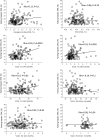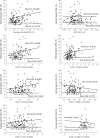Fasting hepatic de novo lipogenesis is not reliably assessed using circulating fatty acid markers
- PMID: 30721918
- PMCID: PMC6367991
- DOI: 10.1093/ajcn/nqy304
Fasting hepatic de novo lipogenesis is not reliably assessed using circulating fatty acid markers
Abstract
Background: Observational studies often infer hepatic de novo lipogenesis (DNL) by measuring circulating fatty acid (FA) markers; however, it remains to be elucidated whether these markers accurately reflect hepatic DNL.
Objectives: We investigated associations between fasting hepatic DNL and proposed FA markers of DNL in subjects consuming their habitual diet.
Methods: Fasting hepatic DNL was assessed using 2H2O (deuterated water) in 149 nondiabetic men and women and measuring the synthesis of very low-density lipoprotein triglyceride (VLDL-TG) palmitate. FA markers of blood lipid fractions were determined by gas chromatography.
Results: Neither the lipogenic index (16:0/18:2n-6) nor the SCD index (16:1n-7/16:0) in VLDL-TG was associated with isotopically assessed DNL (r = 0.13, P = 0.1 and r = -0.08, P = 0.35, respectively). The relative abundances (mol%) of 14:0, 16:0, and 18:0 in VLDL-TG were weakly (r ≤ 0.35) associated with DNL, whereas the abundances of 16:1n-7, 18:1n-7, and 18:1n-9 were not associated. When the cohort was split by median DNL, only the abundances of 14:0 and 18:0 in VLDL-TG could discriminate between subjects having high (11.5%) and low (3.8%) fasting hepatic DNL. Based on a subgroup, FA markers in total plasma TG, plasma cholesteryl esters, plasma phospholipids, and red blood cell phospholipids were generally not associated with DNL.
Conclusions: The usefulness of circulating FAs as markers of hepatic DNL in healthy individuals consuming their habitual diet is limited due to their inability to discriminate clearly between individuals with low and high fasting hepatic DNL.
Figures




Similar articles
-
Palmitoleic acid is elevated in fatty liver disease and reflects hepatic lipogenesis.Am J Clin Nutr. 2015 Jan;101(1):34-43. doi: 10.3945/ajcn.114.092262. Epub 2014 Nov 19. Am J Clin Nutr. 2015. PMID: 25527748 Free PMC article. Clinical Trial.
-
Parallel activation of de novo lipogenesis and stearoyl-CoA desaturase activity after 3 d of high-carbohydrate feeding.Am J Clin Nutr. 2008 Apr;87(4):817-23. doi: 10.1093/ajcn/87.4.817. Am J Clin Nutr. 2008. PMID: 18400702 Clinical Trial.
-
Elevated de novo lipogenesis, slow liver triglyceride turnover, and clinical correlations in nonalcoholic steatohepatitis patients.J Lipid Res. 2022 Sep;63(9):100250. doi: 10.1016/j.jlr.2022.100250. Epub 2022 Jul 11. J Lipid Res. 2022. PMID: 35835205 Free PMC article.
-
Metabolic-associated fatty liver disease and lipoprotein metabolism.Mol Metab. 2021 Aug;50:101238. doi: 10.1016/j.molmet.2021.101238. Epub 2021 Apr 20. Mol Metab. 2021. PMID: 33892169 Free PMC article. Review.
-
Role of Dietary Fructose and Hepatic De Novo Lipogenesis in Fatty Liver Disease.Dig Dis Sci. 2016 May;61(5):1282-93. doi: 10.1007/s10620-016-4054-0. Epub 2016 Feb 8. Dig Dis Sci. 2016. PMID: 26856717 Free PMC article. Review.
Cited by
-
Serum lipid analysis and isotopic enrichment is suggestive of greater lipogenesis in young long-term cannabis users: A secondary analysis of a case-control study.Lipids. 2022 Mar;57(2):125-140. doi: 10.1002/lipd.12336. Epub 2022 Jan 24. Lipids. 2022. PMID: 35075659 Free PMC article.
-
Plasma lipidomic profiles after a low and high glycemic load dietary pattern in a randomized controlled crossover feeding study.Metabolomics. 2020 Nov 20;16(12):121. doi: 10.1007/s11306-020-01746-3. Metabolomics. 2020. PMID: 33219392 Free PMC article. Clinical Trial.
-
Fatty acids in the de novo lipogenesis pathway and incidence of type 2 diabetes: A pooled analysis of prospective cohort studies.PLoS Med. 2020 Jun 12;17(6):e1003102. doi: 10.1371/journal.pmed.1003102. eCollection 2020 Jun. PLoS Med. 2020. PMID: 32530938 Free PMC article.
-
Managing NAFLD in Type 2 Diabetes: The Effect of Lifestyle Interventions, a Narrative Review.Adv Ther. 2020 Apr;37(4):1381-1406. doi: 10.1007/s12325-020-01281-6. Epub 2020 Mar 7. Adv Ther. 2020. PMID: 32146704 Free PMC article.
-
Using an erythrocyte fatty acid fingerprint to predict risk of all-cause mortality: the Framingham Offspring Cohort.Am J Clin Nutr. 2021 Oct 4;114(4):1447-1454. doi: 10.1093/ajcn/nqab195. Am J Clin Nutr. 2021. PMID: 34134132 Free PMC article.
References
-
- Hellerstein MK, Schwarz JM, Neese RA. Regulation of hepatic de novo lipogenesis in humans. Annu Rev Nutr. 1996;16:523–57. - PubMed
-
- Wilke MS, French MA, Goh YK, Ryan EA, Jones PJ, Clandinin MT. Synthesis of specific fatty acids contributes to VLDL-triacylglycerol composition in humans with and without type 2 diabetes. Diabetologia. 2009;52(8):1628–37. - PubMed
Publication types
MeSH terms
Substances
Grants and funding
- BB/N005600/1/BB_/Biotechnology and Biological Sciences Research Council/United Kingdom
- FS/15/56/31645/BHF_/British Heart Foundation/United Kingdom
- BB/N015665/1/BB_/Biotechnology and Biological Sciences Research Council/United Kingdom
- PG/09/003/BHF_/British Heart Foundation/United Kingdom
- FS/11/18/28633/BHF_/British Heart Foundation/United Kingdom
LinkOut - more resources
Full Text Sources
Research Materials
Miscellaneous

